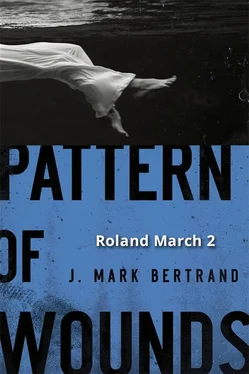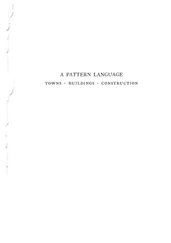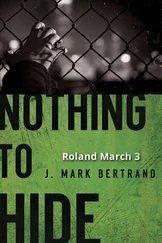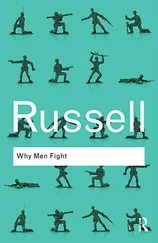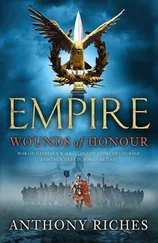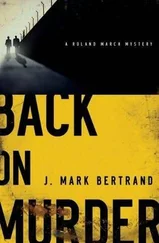J. Bertrand - Pattern of Wounds
Здесь есть возможность читать онлайн «J. Bertrand - Pattern of Wounds» весь текст электронной книги совершенно бесплатно (целиком полную версию без сокращений). В некоторых случаях можно слушать аудио, скачать через торрент в формате fb2 и присутствует краткое содержание. Год выпуска: 0101, Издательство: Baker Publishing Group, Жанр: Полицейский детектив, на английском языке. Описание произведения, (предисловие) а так же отзывы посетителей доступны на портале библиотеки ЛибКат.
- Название:Pattern of Wounds
- Автор:
- Издательство:Baker Publishing Group
- Жанр:
- Год:0101
- ISBN:нет данных
- Рейтинг книги:3 / 5. Голосов: 1
-
Избранное:Добавить в избранное
- Отзывы:
-
Ваша оценка:
- 60
- 1
- 2
- 3
- 4
- 5
Pattern of Wounds: краткое содержание, описание и аннотация
Предлагаем к чтению аннотацию, описание, краткое содержание или предисловие (зависит от того, что написал сам автор книги «Pattern of Wounds»). Если вы не нашли необходимую информацию о книге — напишите в комментариях, мы постараемся отыскать её.
Pattern of Wounds — читать онлайн бесплатно полную книгу (весь текст) целиком
Ниже представлен текст книги, разбитый по страницам. Система сохранения места последней прочитанной страницы, позволяет с удобством читать онлайн бесплатно книгу «Pattern of Wounds», без необходимости каждый раз заново искать на чём Вы остановились. Поставьте закладку, и сможете в любой момент перейти на страницу, на которой закончили чтение.
Интервал:
Закладка:
Only the guilty look relieved when their misdemeanors are uncovered. They hope finding the smaller offenses will blind us to their felonies.
His windows of his upstairs office look out onto the backyard. But the swimming pool where Simone Walker died is entirely screened from view by the hedge and Bayard’s own four-car garage, which sides diagonally across part of the yard. For a desk he uses a long antique table with a green marbled leather top and brass corners. On closer inspection it appears to be a high-dollar reproduction.
Aguilar makes him unlock each of the drawers in turn while I scan the floor-to-ceiling bookcases that line the room on three sides. The bottom rows are occupied by oversized coffee-table books, mainly art and photography, with hardbacks on the middle rows and smaller volumes above eye level. There’s even a ladder that runs along a brass rail.
One section of shelving holds not books but a series of locking glass cases. Inside, a series of knives are displayed under pinpoint lights. Seeing my interest, Bayard actually moves to the wall and twists a dimmer dial, bringing up the luster of the blades. He appears at my side, smiling, not even trying to conceal his pride.
“Are you a collector, as well?” he asks.
“No,” I say. “It’s just that my victim, she was gutted with a knife like one of these.”
A condescending smile. “I doubt it was like one of these .”
I’m tempted to wipe that smile off his face by rattling off the details: SCHARF. OLD SCHOOL BOWIE, #29 OF 50. But I’m not here to clue him in on our case. Besides, he already knows. He dropped his prized weapon on my bedroom floor.
“March.”
I turn to find Aguilar at an open desk drawer. In his gloved hand he holds a small, thick paperback book.
The Kingwood Killing by Brad Templeton.
“I’m a reader,” Bayard says, laughing nervously. “What can I say?”
I take the book in my own gloved hands, flipping through its pages. The glossy photo insert appears pristine. There are no markings inside. I’m about to hand it back for bagging when I notice something on the flyleaf. A handwritten inscription in ink.
FOR DAVID,
THANKS FOR YOUR INTEREST!
ALL THE BEST,
BRAD TEMPLETON
“I knew him,” Bayard is saying. “The Donald. Donald Fauk. Unbelievable story.” He pauses. “ You’re not. . Are you the same Detective March-?” He reaches for the book.
I hand it to Aguilar, who seals the paperback in a plastic evidence bag.
“You’re taking that?” Bayard says. “I don’t get it.”
“Have you been consulting the book recently?” I ask. “It’s in your desk drawer.”
“What? No, of course not. I don’t even know what it’s doing there.”
“But it is your book? You’re not denying that.”
“Yeah.” His big shoulders slump in defeat. “It’s mine.”
A narrow staircase leads up to the attic, hidden behind a locked door. We ascend single file: Aguilar, Bayard, me, Nguyen. Through another door, we enter a small finished room with a cork floor, a small tufted couch, an older television set with a dusty VCR player attached.
“This was originally going to be a media room,” Bayard says, “but when David Junior moved out I just decided to convert his room. It’s bigger.”
Along the wall, a row of empty bottles are stacked, their labels soaked off. I count eight of them. At the end of the line there’s a metal gasoline container, the type you’d find in a garage next to a lawn mower. I lift it with a gloved hand. Next to empty.
“What’s the deal with all this?” I ask. “You making Molotov cocktails?”
“Hardly,” he says. “I don’t know what these are doing here.”
“We need to photograph these, then take them,” I say to Aguilar. “Check them for prints. Mr. Bayard, if you’ve been manufacturing explosives-”
“I told you I don’t know what they’re doing here.”
“Then who does?”
He says nothing.
“And what’s through here?” I ask, indicating a small door on the far side of the room, half blocked by the couch.
“Nothing. Just storage. The eaves were too low to make finishing it out worthwhile.”
“Let’s take a look.”
We drag the couch out of the way. Reaching inside, I flip on a row of bald bulbs nestled inside the exposed framing. There are some cardboard boxes stacked near the door. Beyond them, nothing but plywood flooring over joists.
“Where’s the window?” I ask.
“The window?”
“There’s a window overlooking the neighbor’s pool.”
He rubs his chin again. “Oh. It’s just decorative. You’d have to walk across the joists that way to reach it.” He points past the boxes into the darkness. “The finished room kind of boxes it in, so you have to go around. There’s no light, though.”
I pull my Fenix light. “Not a problem.”
Leaving Bayard with Nguyen, I start across the joists with Aguilar balancing behind me, taking it slow so we don’t lose our footing. I don’t fancy the idea of plunging through a high ceiling, landing two floors down or getting impaled on a chandelier.
“You think it’s booby-trapped?” Aguilar whispers.
“Because of the bottles?” I smile. “Guess we’ll find out. You wanna go first?”
“Be my guest.”
We keep the wall of the finished room on our right, turning the corner after a minute of slow progress. Ahead, I spot a faint slit of light and start toward it.
The window is closer than it appears. A length of blackout cloth hides most of the light. With the aid of my flashlight I make out a loose piece of plywood situated at the window to serve as a makeshift floor. On top, there’s a metal folding chair. Under the chair, a wooden cigar box with the lid ajar. As I get closer I see something concealed behind a flap of blackout cloth, perched on the windowsill.
“What is that?” Aguilar says.
I reach the plywood and move across. I draw the curtain back. Standing on the ledge, a pair of black binoculars, expensive ones, with a red dot Leica logo.
From the window I can see over the hedge and into Dr. Hill’s backyard. The pool glistens in the cloudy daylight. A woman sunbathing by the water would be easy to observe. I lift the binoculars with two fingers, raising them just in front of my eyes. I can make out the detail of the slate surrounding the pool, the latticework of the metal chairs. From here, using these binoculars, he could have studied every inch of her at leisure.
Aguilar clears his throat. “Look at this.”
I put the binoculars down. On the edge of the platform, there’s another bottle. This one is three quarters full, with some wadding stuffed down the neck. I run my light all around it, looking for tripwires. Nothing.
“I’ve seen some weird things in my time,” Aguilar says, “but this. .”
“Let’s take a look in that cigar box.”
I prop it open with a pen. There’s a bag of weed inside, some rolling papers, and a fat white envelope with something sticking out. I turn the edge of the envelope. A stack of photographs. Digital shots output on an inkjet printer. Aguilar shines a light with his free hand. I ease the deck of photos out, flipping through them one by one.
“That’s the Polish girl,” he says.
Oliszewski in a flower-print bikini stretched on a recliner by the pool. On her back. On her stomach. On her stomach again, undoing her top with a twisted hand.
“And Simone.”
One shot after another: Simone in a variety of swimsuits, in the water and out. Sitting under the pergola. Talking on the phone. Looking at the screen of her laptop. And then I flip the photo and Aguilar jumps.
“No way.”
Simone stripped to the waist, lying facedown on the slate, her legs in the water, the bloody wounds chewing up her back. It’s a grainy, nighttime photo, snapped from a few feet above the body. I flip to the next one. Night again, but bright this time. Illuminated by the crime scene lights. The photo, taken from the window, shows three dark silhouettes around the pool. A tall man, a shorter one, a plump woman in a white jumpsuit. Bascombe. Me. Dr. Green.
Читать дальшеИнтервал:
Закладка:
Похожие книги на «Pattern of Wounds»
Представляем Вашему вниманию похожие книги на «Pattern of Wounds» списком для выбора. Мы отобрали схожую по названию и смыслу литературу в надежде предоставить читателям больше вариантов отыскать новые, интересные, ещё непрочитанные произведения.
Обсуждение, отзывы о книге «Pattern of Wounds» и просто собственные мнения читателей. Оставьте ваши комментарии, напишите, что Вы думаете о произведении, его смысле или главных героях. Укажите что конкретно понравилось, а что нет, и почему Вы так считаете.
